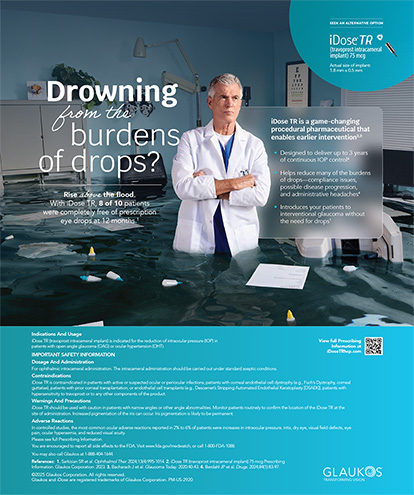Selecting the optimal ophthalmic viscosurgical device (OVD) is invaluable, especially for complex anterior segment surgery. During routine cataract procedures, agents with viscous cohesive properties maintain space and stabilize tissues for the capsulorhexis and the IOL's implantation. Dispersive OVDs protect the endothelium during the turbulence of the lens' removal. I have favored Duovisc, which contains Provisc (used for its viscous cohesiveness) and Viscoat (for its dispersive properties) with a soft shell technique (all products from Alcon Laboratories, Inc., Fort Worth, TX). Composed of 4% sodium chondroitin sulfate and 1.65% sodium hyaluronate, DisCoVisc (Alcon Laboratories, Inc.) is the first and only viscous dispersive agent combining both properties in one device.
CLINICAL BEHAVIOR
The clinical behavior of OVDs is, to a great extent, conveyed by the cohesive/dispersive index (CDI). The higher the ratio is, the better space is maintained under conditions of low shearing (no flow), and the easier an OVD evacuates under conditions of high flow (eg, irrigation).
For the average case, I use Provisc (CDI of 50) while creating the capsulorhexis. When seeking maximal depth in shallow chambers and for pediatric or intumescent cataracts, I prefer Healon GV (CDI of 72) (Abbott Medical Optics Inc., Santa Ana, CA) to help keep the dome of the lens controlled for a safe capsulorhexis. During phacoemulsification, I primarily desire the endothelial protection conferred by an OVD with a low CDI such as Viscoat (CDI of 3.5). DisCoVisc's intermediate CDI of 12 explains its clinical behavior in both maintaining space and remaining against the endothelium, but its CDI is not optimal for either indication. This OVD allows ophthalmologists who wish to streamline their surgery to avoid the need for two viscoelastic injections in order to have most of the best of both worlds.
I find that DisCoVisc performs well for routine cases by not impeding the movement of the capsule like Viscoat can, and the former also allows me to "feel" the vectors as the curvilinear tear progresses. Hydrodissection proceeds as usual without requiring me to create a path for the egress of fluid to prevent tamponade of the capsulorhexis' edge—a necessary step with the highly viscous, viscoadaptive Healon5 (Abbott Medical Optics Inc.). In my experience, DisCoVisc remains in place almost as well as Viscoat does during phacoemulsification and does not need to be "ironed out" under the endothelium with a soft shell technique. DisCoVisc remains optically clear, so I do not need to fill the OVD into itself as I do with Viscoat when refilling the chamber during the phacoemulsification of brunescent lenses. Although DisCoVisc's removal endpoint is more difficult to visualize than Viscoat's, I find that its retention is seldom great enough to cause significant postoperative pressure spikes. If unavoidably retained, Viscoat, in my experience, is the most forgiving of all OVDs in terms of IOP.
PERSONAL PREFERENCES
A clinical situation in which I find DisCoVisc particularly helpful is the postvitrectomized eye requiring anterior segment "gymnastics" (eg, for secondary implants or subluxated IOLs). Michael Snyder, MD, taught me that DisCoVisc performs excellently in these cases because of its combined viscous and dispersive properties. Filling the anterior chamber from its distal to proximal point with the OVD completely displaces the aqueous humor. Next, I irrigate through the zonules with BSS (Alcon Laboratories, Inc.) until the posterior segment is firm. The OVD prevents backwashing or the escape of BSS, pressurizes the eye to avoid the globe's deflation, and facilitates subsequent maneuvers.
In cases complicated by posterior capsular rupture or when compartmentalization is needed, Viscoat remains my preference. The OVD covers and stabilizes breaks in the capsule, and it partitions residual lenticular material from the prolapsed vitreous. The agent's dispersive property helps to cover exposed areas of the vitreous face in a region of broken zonules. Packing Viscoat into place by then placing Provisc over it is an excellent way of preventing vitreous from presenting before subsequent maneuvers in cases of a subluxated crystalline lens.
I only employ Healon5 for eyes with intraoperative floppy iris syndrome. I find the OVD's cement-like viscosity helpful in these cases, especially when combined with Viscoat in the Arshinoff soft shell technique. Healon5 not only holds tissue in place, but it can be used for viscomydriasis in an eye with a poorly dilating pupil. The OVD can be tricky to use, however, because it is easy to overfill and overly pressurize the chamber, leading to complications; the trajectory of the capsulorhexis does not progress naturally, and hydrodissection must be carefully managed. Unless very low fluidic parameters (in the range of 250-mm Hg vacuum and a 25-mL/min flow rate) are employed, Healon 5 loses its dispersive qualities and evacuates, thus exposing the endothelium. If a complication occurs that makes turbulence undesirable, I find it is difficult to effect the complete removal of this OVD, because its dispersive qualities persist in conditions of low shearing. Finally when retained, Healon 5's high molecular weight structure leads to severe and prolonged pressure spikes.
CONCLUSION
When limited to one OVD, DisCoVisc is my first choice as a jack of all trades. As the saying goes, however, it may be the master of none. I approach every case as potentially complex or complicated, and having the best tool for any eventuality fits my belt-and-suspenders approach.
Lisa Brothers Arbisser, MD, is in private practice with Eye Surgeons Assoc. PC, located in the Iowa and Illinois Quad Cities. Dr. Arbisser is also a clinical adjunct associate professor at the John A. Moran Eye Center of the University of Utah in Salt Lake City. She has received honoraria from Alcon Laboratories, Inc. Dr. Arbisser may be reached at (563) 323-2020; drlisa@arbisser.com.


